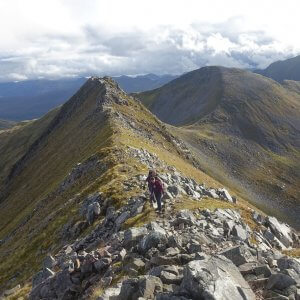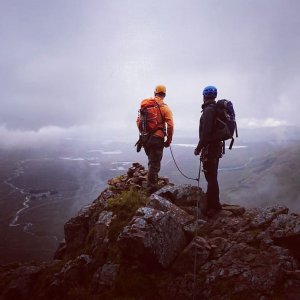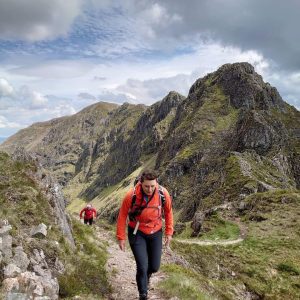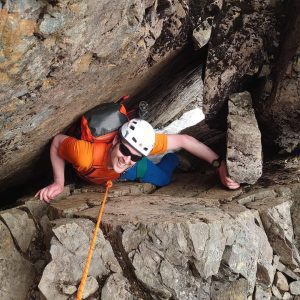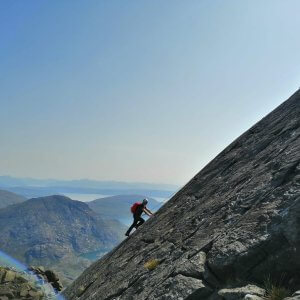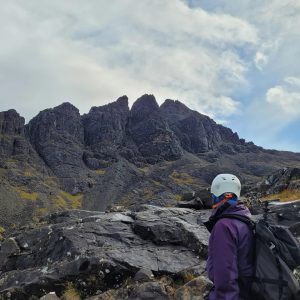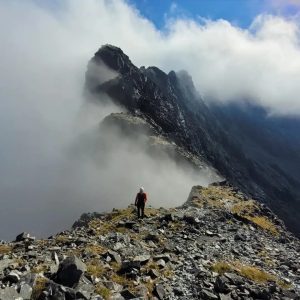Sweeping Ridge Lines
Iconic Peaks
Classic scrambles
Scrambling is a very broad term, covering the “grey area” between walking and climbing. From narrow sweeping ridges with little technical difficulty but high exposure, to more complex rock ascents where the use of a rope, climbing equipment and techniques such as abseiling may be employed. The upper end of the scrambling grading spectrum overlaps with the lower end of the rock climbing grading spectrum
Fitness grading/trip difficulty:
⛰️ Introductory:
suitable for beginners or those of limited experience
⛰️⛰️ Challenging:
previous hillwalking experience and a good level of fitness is desirable
⛰️⛰️⛰️ Demanding:
previous hillwalking experience and good level of fitness required. Prior training (e.g: for Skye Cuillin,) may be required to improve confidence and/or fitness
A grading system of ‘chillis’ is used to indicate the ‘spice’ factor
🌶️ = a logical first progression for those who wish to move beyond hillwalking. The majority of clients will be comfortable without a rope throughout, for all but the most exposed sections. These days allow a larger instructor to client ratio and focus on improving personal scrambling movement skills in a safe environment. (1:6 max)
🌶️🌶️ = a bit more hands on – literally! Expect to use hands more for balance and occasionally upward progress. Some sections will be exposed but the climbing never too hard. These days are typically exposed ridges on big hills such as Liathach. Previous rough walking or scrambling experience beneficial. (1:4 max)
🌶️🌶️🌶️ = Good fitness and a head for heights required. A rope is more than likely to be deployed for some or all of the scrambling, due to exposure or technical difficulty. Hands will be used for upward progress and some steep rock sections may be encountered. Starting to introduce basic climbing components such as belaying and removal of gear. (1:3 max)
🌶️🌶️🌶️🌶️ = Moving into the realms of serious scrambling (grade 3 and upwards). Verging on rock climbing: in some instances rope, climbing equipment and more advanced techniques such as abseiling may be used. Previous scrambling experience beneficial or required in some cases. (1:2 max)
Single Day Scrambles
Multi Day Scrambles
When does ‘scrambling’ become ‘climbing’?
Scrambling grades
Understanding Scrambling Grades
Climbing grades
A Brief Explanation of UK Traditional Climbing Grades
THE FOLLOWING TABLE HERE SHOWS HOW THE GRADES RELATE TO EACH OTHER
| Scrambling Grades | Basic Traditional Climbing Grades |
|
Grade 1 – easy scrambling, often exposed ridgelines. Good movement and confidence other than a protected climb. Hands may be used for balance occasionally but rarely for upward progress. e.g: CMD arete
|
|
|
Grade 2 – more complex and exposed scrambling, often with more complex route-finding. Less confident/experienced parties will want the reassurance of a rope. Hands will be used for balance and upward progress. e.g: Liathach
|
|
| Easy: there are actually very few ‘Easy’ graded rock climbs, as most have been subsumed within the newer scrambling grades. e.g: Ledge Route (direct) | |
| Moderate: often classed as a ‘mountaineering route’. Commonly climbed in big boots not rock shoes but employing the use of a rope and simple climbing techniques. Expect difficulties to be short lived and not sustained, but potentially very exposed. Abseiling possible. e.g: Curved Ridge or In Pinn | |
|
Grade 3 – moving into the realms of rock-climbing, often involving short sections of steep, complex and exposed ground. Some rock climbing up to Moderate standard. Only experienced climbers will feel confident without a rope. The ability to retreat/descend via abseil may be useful. Hands will be used for upward progress. Downclimbing my also be involved. e.g: Curved Ridge. most sections of the Cuillin RIdge
|
|
| Difficult: actually considered to be rather ‘easy’(!) in the modern climbing context. Big boots will still be worn.Expect the holds to still be good, but the angle steeper and the use of a rope more common and continuous. Abseiling likely. e.g: Tower Ridge / Clach Glas-Blaven Traverse | |
| Very Difficult: firmly in the realms of rock climbing, but short sections may be encountered on big mountaineering routes. Still do-able in big boots and still good handholds, albeit steep. Expect exposure, more complex climbing techniques and continuous use of a rope in ascent and descent. e.g: Pinnacle Ridge (Skye), Agag’s Groove | |
| Severe, Very Severe, etc upwards: Definitely rock climbing. Expect to wear climbing shoes unless very experienced, and to require continuous use of rope and advanced climbing techniques |

